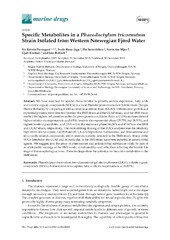| dc.contributor.author | Prestegard, Siv Kristin | |
| dc.contributor.author | Erga, Svein Rune | |
| dc.contributor.author | Steinrücken, Pia | |
| dc.contributor.author | Mjøs, Svein Are | |
| dc.contributor.author | Knutsen, Gjert | |
| dc.contributor.author | Rohloff, Jens | |
| dc.date.accessioned | 2016-08-05T12:10:45Z | |
| dc.date.available | 2016-08-05T12:10:45Z | |
| dc.date.issued | 2016-12-30 | |
| dc.Published | Marine Drugs 2016, 14(1):9 | eng |
| dc.identifier.issn | 1660-3397 | en_US |
| dc.identifier.uri | http://hdl.handle.net/1956/12476 | |
| dc.description.abstract | We have searched for special characteristics in growth, protein expression, fatty acids and volatile organic compounds (VOCs) in a local Phaeodactylum tricornutum Bohlin strain (Bergen Marine Biobank), by comparing it with a common accession strain (CCAP). Differences in growth and expressed proteins were detected between the BMB strain and the CCAP strain, and the BMB strain reached the highest cell densities under the given growth conditions. Fatty acid (FA) analyses showed highest relative eicosapentaenoic acid (EPA) levels in the exponential phase (25.73% and 28.31%), and highest levels of palmitoleic acid (16:1 n-7) in the stationary phase (46.36% and 43.66%) in the BMB and CCAP strain, respectively. The most striking finding of the VOCs analyses was the relatively high levels of ectocarpene, 6-((1E)-butenyl)-1,4-cycloheptadiene, hormosirene, and desmarestene and structurally related compounds, which were exclusively detected in the BMB strain. Many of the VOCs detected in the CCAP and, in particular, in the BMB strain have been reported as antimicrobial agents. We suggest that the array of pheromones and antimicrobial substances could be part of an allelopathic strategy of the BMB strain, dominated by oval cells, thus reflecting the benthic life stage of this morphological form. These findings show the potential for bioactive metabolites in the BMB strain. | en_US |
| dc.language.iso | eng | eng |
| dc.publisher | MDPI | en_US |
| dc.relation.uri | http://www.mdpi.com/1660-3397/14/1/9 | |
| dc.rights | Attribution CC BY | eng |
| dc.rights.uri | http://creativecommons.org/licenses/by/4.0 | eng |
| dc.subject | Phaeodactylum tricornutum | eng |
| dc.subject | two-dimensional gel electrophoresis (2DGE) | eng |
| dc.subject | volatile organic compounds (VOCs) | eng |
| dc.subject | hormosirene | eng |
| dc.subject | ectocarpene | eng |
| dc.subject | fatty acids | eng |
| dc.subject | Eicosapentaenoic acid (EPA) | eng |
| dc.title | Specific metabolites in a Phaeodactylum tricornutum strain Isolated from Western Norwegian fjord water | en_US |
| dc.type | Peer reviewed | |
| dc.type | Journal article | |
| dc.date.updated | 2016-04-08T11:24:13Z | |
| dc.description.version | publishedVersion | en_US |
| dc.rights.holder | Copyright 2015 The Authors | en_US |
| dc.identifier.doi | https://doi.org/10.3390/md14010009 | |
| dc.identifier.cristin | 1305219 | |
| dc.relation.project | Norges forskningsråd: 139710/140 | |

